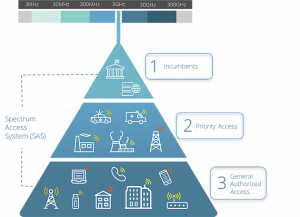
In a recent blog, CBRS Alliance Chairman Neville Meijers provided an overview of the new CBRS 3.5 GHz spectrum band and the business opportunities it opens up.
In this blog, I want to focus on one specific element of the CBRS architecture: the Spectrum Access System (SAS). The SAS makes possible the advanced three-tier spectrum sharing framework adopted by the FCC for CBRS. The novel three-tier sharing framework coordinates spectrum access among the incumbent military radars, satellite earth stations, and new commercial users. The three tiers of use are Incumbent, Priority Access License (PAL), and General Authorized Access (GAA). The SAS is an advanced, highly automated radio spectrum coordinator within the CBRS 3.5 GHz band, and is tasked with protecting the higher-tier users from lower-tier users and optimizing efficient use of the available spectrum in the band for all users. As a result, the 150 MHz of CBRS spectrum is dynamically shared. The SAS maintains a database of all CBRS radio base stations including their tier status, geographical location, and other pertinent information to coordinate frequency and transmit power assignments, and to monitor and protect the band from potential interference.
Figure 1. The Three-Tiered Spectrum Access System (SAS)
Per the FCC rules, at least 80 MHz of spectrum will be available for General Authorized Access (GAA) use (assuming no Incumbents are present), and in some cases the full 150 MHz will be available if there are no Incumbents or Priority Access users in an area. The SAS applies a series of sophisticated algorithms to ensure that FCC rules are enforced at all times, while giving maximum access to available spectrum. An important aspect of the SAS is that users of the shared spectrum resources are always under the authoritative control of the SAS. This assures protection of the top tier incumbent users, which is especially important for federal users.
Federal use of the 3.5 GHz band is relatively rare, but vital when needed. That’s what made this band so attractive for commercial use and so viable for the shared spectrum model. To help ensure that Federal Incumbents are always given the highest priority access, the Spectrum Access System coordinates with Environmental Sensing Capability (ESC) sensors. ESC sensors are deployed along the U.S. coastline so that Naval radars operating in 3.5 GHz are protected from any interference by shared spectrum users. ESC sensors securely detect shipborne Incumbent use and inform the SAS, which reallocates shared spectrum users to other available channels within the 3.5GHz spectrum band.
Figure 2. Environmental Sensing Capability (ESC) Detects and Informs Incumbent Activity
The SAS also includes incumbent protections for Fixed Satellite Systems and other grandfathered Wireless Internet Service Providers through exclusion zones and the utilization of aggregate interference data. The SAS applies this real-time sensing and database information to enforce the hierarchical spectrum sharing regulations and to determine spectrum availability and assign spectrum to individual radios or networks of radios. This is all done in a fair, secure, and dynamic manner, without the need for manual intervention and without interruption to either incumbent or commercial services.
The wireless world is becoming more sophisticated every day in response to the growing demand for cost-effective bandwidth. The CBRS Alliance is working to commercialize all the elements of the CBRS architecture so that Spectrum Access Systems and CBRS radios can be deployed quickly and with the confidence that they are interoperable and meet industry standards. The standards are in place, the enabling technology is available, the ecosystem is growing rapidly, and FCC certification is imminent. What’s so exciting about this new development in the wireless market is the wide range of existing and emerging applications that it makes possible – enabling new business models to efficiently deliver LTE services.


